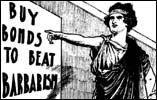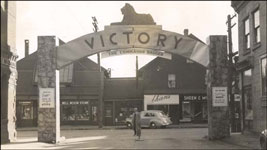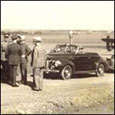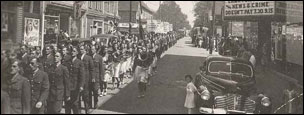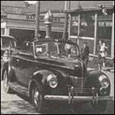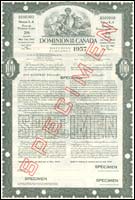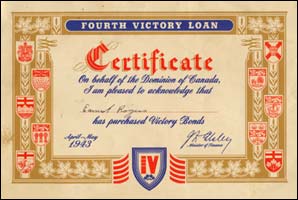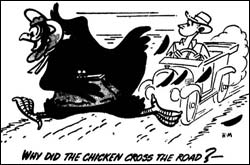Time after time Summerside supported the drives, which were well organized by local citizens such as L. R. Allen, L.W. Hancock, J. Watson MacNaught, and W. J. Lidstone, all energetic and creative campaigners. The newspapers were filled with huge advertisements promoting the purchase of the bonds. They were offered at a 3% interest rate and could be acquired from salesmen during the national drives, from banks and trust companies, or through a Payroll Savings Plan. The bonds became the precursors to the later established Canada Savings Bonds.
Prior to the nine "Victory Loan" drives held between June 1941 and October 1945, the government conducted two drives for "War Loans." The first one held in January 1940 met with an overwhelming response. The second War Loan was launched in September 1940 with an objective of $300 million. Canadians oversubscribed by $42 million. When the next loan period was introduced to the public in June 1941 the government capitalized on the patriotic feelings aroused by the "V for Victory" slogan and symbol and labeled the lending program as a Victory Loan drive.

Loan # 1

To kick off the campaign, the Summerside Citizen's Committee for Victory Loans erected a huge arch at the intersection of Summer and Water Streets. To supplement this strategically placed structure, a 16-foot thermometer was set up downtown to record the progress of sales. A large ad in the Summerside Journal stated, "Mr. and Mrs. Summerside - will you help sell Victory Bonds?"
Everyone was encouraged to decorate their homes with flags, bunting, and coloured lights for the start of the campaign on 2 June. A special 16-page supplement to the Journal promoted the drive and launch day featured a parade and community singsong. The Town of Summerside itself purchased $40,000 worth of bonds to get the campaign underway and the race was on to surpass other Canadian communities of a similar size.
On June 11 the Montreal Daily Star stated on its front page "Summerside Leads." Two days later, the Ottawa Journal printed an article titled, "Summerside, PEI to the Fore in Victory Loan." A local editorial praised the citizens for their splendid showing and remarked that, "This province and this section of it gave of its blood and treasure in the last war and it is again making a magnificent contribution to the Empire in men and money." A small blue Honour pennant was added to the flagpole on the Town Hall each time the objective was exceeded by 25%. The campaign reached a climax with the arrival of the national Victory Torch at the airport and culminated with the town earning a 4th pennant to fly on its civic building as evidence that it had exceeded its goal by over 200%. This outstanding success was echoed in later campaigns with Summerside repeatedly going "Over the Top", even when the quota was consistently increased. [ More ]

Loan # 2

In February 1942, the second drive raised $337,350. During the summer of 1942, ads began to appear encouraging citizens not to sell their bonds prematurely. "Don't Be a Welsher" was the phrase used by government. The Royal Bank stated, "It is your duty, as well as good sense, to keep them." [More]

Loan # 3

In October of 1942, a Commando Dagger was used to symbolize the third drive, which resulted in the sum of $389,000 for Summerside. Following a parade over which a squadron of planes from the RCAF Station saluted, a special community gathering was held at the Capitol Theatre where a dagger was presented to the town for exceeding its objective. It was one of 722 army issue daggers ceremoniously presented to communities across Canada and then sent overseas to Canadian regiments. [ More ]
 | 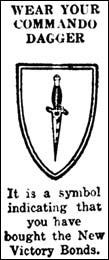 |
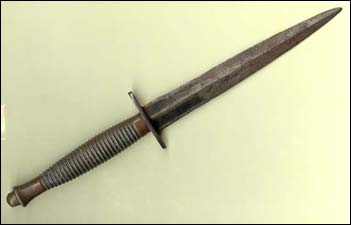 |

Loan #4

The fourth campaign was a special one because of the method of sales. An auction sale of "Attack Equipment" interspersed with musical entertainment at the High School brought in $332,000 within two hours. Through this effort the town raised an amazing 83% of its goal on the second day of the campaign. A few days later it was the first town in the Dominion to go over the top and local MP/Defence Minister James L. Ralston telegrammed his congratulations. After every campaign to that point he had expressed gratitude and praise for Summerside's response. This time he simply wrote, "Summerside's past records have used up my supply of superlatives." The organizers, with L. W. Hancock in the lead, followed up with a radio auction to sell $50 aerial bombs, another effort well received and supported.
Another part of the local campaign was the creation of a Service Roll Gallery in the window of Holman's furniture department. It was estimated that 20,000 persons viewed the display of photos of local men and women serving in the military. The Publicity Committee arranged the material relating to the campaign in a portfolio, which was sent to Ottawa as an entry in the National War Committee trophy contest. It won honorable mention for best promotional idea. [ More ]

Loan #5

The fifth loan drive - "Speed the Victory" - got off to a good start in October 1943 when the firm of R. T. Holman Ltd. subscribed $100,000. At a "Monster Victory Loan Rally" held in the High School, L. R. Allen, Chairman of the 5th Loan, announced that in order to reach the $550,000 objective a $110 subscription would be required for every person in the town. The campaign also featured a War Bond Radio Sale broadcast over radio station CHGS on 26 October 1943 with entertainers from the RCAF Station. Once more the drive was very successful, taking Summerside over the top. [ More ]

Loan # 6

The sixth campaign got underway in April 1944 with the public sale of "Invasion Equipment" held in the school auditorium. It featured as entertainment the Canadian Women's Army Corps band. Clarence Harris was Summerside's best salesman, having obtained 285 applications for a total of $90,000 in bonds. During the campaign Summerside residents were able to view the scrapbook that had won honourable mention for the town when it was sent to Ottawa after the 4th loan drive. Even though the town exceeded its goal by 108%, there was an interesting editorial titled "There is a Limit" about what was expected of Summerside and Prince County in the setting of quotas. [ More ]

Loan # 7

An editorial with the title "Why" outlined the necessity of a high objective in the 7th campaign held in October 1944. The slogan this time was "Invest in Victory" and the goal $530,000. Local businessman M. L. Bradshaw subscribed $30,000 and Holman's Ltd. $100,000 to get the drive off to a fine start. Members of the No. 1 GRS presented a Victory Loan Revue and special "News Periods" were broadcast over CHGS radio. This campaign had its own national song. When the drive ended with the clanging of fire bell, sirens, and whistles, the objective had once more been exceeded. [ More ]

Loan # 8

The eighth drive under the slogan "Invest in the Best" started in April 1945 with M. L. Bradshaw this time subscribing $50,000 and Holman's once more $100,000. Always diligent in its promotion of the campaigns, the Journal carried an editorial on "Good Citizenship" in which the writer referred to the Victory Loans providing the "sinews of war" and encouraged everyone to be supportive. "There can be no let down in our efforts on the home front." An address given in Halifax by Graham F. Towers, general chair of the National War Finance Committee and Governor of the Bank of Canada, explained the status of the economy and the need for Canadians to continue to invest a portion of their income in bonds.
Citizens were tiring of the war effort, but were encouraged to continue their support. Numerous articles, ads, and even cartoons appeared in the newspapers to promote the 8th drive. Many of the retailers had special window displays and a Mosquito Bomber known as "F for Freddie" made several circles over Summerside as part of a national publicity tour for bond sales. The town's achievement of 143% of the goal placed Summerside second in Canada, after Glace Bay, N.S., in the inter-city contest. [ More ]

Loan # 9

 The ninth Victory Loan campaign held in October 1945 was carried out with the usual meetings of salesmen and promotional programming. A large ad placed with the press outlined nine reasons to purchase bonds and explained that this loan would be "the real test of Canadians' determination to finish the job." A local editorial used the phrase "Let's Make Sure of the Roof" to describe the need for another loan. A review of the nation's loan record appeared in the newspapers. This time the Mutual Fire Insurance Company based in Summerside subscribed $80,000 and the firms of Brace McKay, R. T. Holman, Sinclair & Stewart, and M. L. Bradshaw subscribed $25,000 each. The townspeople subscribed 183% and PEI as a whole made its greatest showing with 150% of its quota. [ More ]
The ninth Victory Loan campaign held in October 1945 was carried out with the usual meetings of salesmen and promotional programming. A large ad placed with the press outlined nine reasons to purchase bonds and explained that this loan would be "the real test of Canadians' determination to finish the job." A local editorial used the phrase "Let's Make Sure of the Roof" to describe the need for another loan. A review of the nation's loan record appeared in the newspapers. This time the Mutual Fire Insurance Company based in Summerside subscribed $80,000 and the firms of Brace McKay, R. T. Holman, Sinclair & Stewart, and M. L. Bradshaw subscribed $25,000 each. The townspeople subscribed 183% and PEI as a whole made its greatest showing with 150% of its quota. [ More ]
Overview of the loans. | Gallery of local ads supporting each campaign.
| Related Articles | Related Images | Related Memories | Related Websites | Inflation Calculator |
| Home Page | Site Map | Contact Us | Wyatt Heritage Properties |




